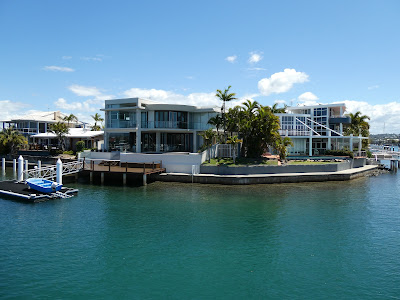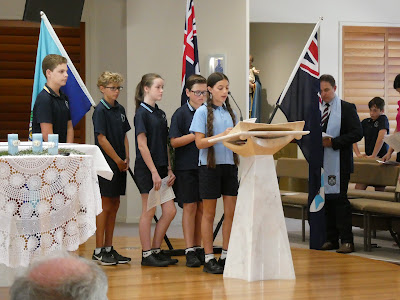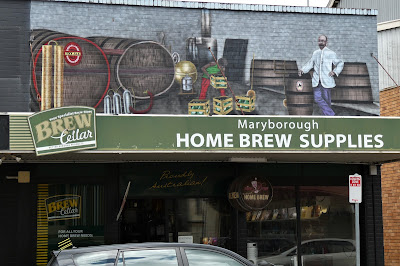
and the nearby Post Office building both speak to the former wealth and glory of this town.
As I completed the preview of this missive, I saw that at this point the left margin had, for some reason which is utterly beyond either my comprehension as to why, or, more importantly, my ability to easily fix it, had altered. After some time spent on reparation, clearly unsuccessful, I have decided to let it be (apart from this proffered explanation and apology that is).
For those in need of some spiritual comfort, there is no shortage of places of worship, and like a number of the commercial and public authority buildings of Maryborough, many of its churches reflect the glory days.
We did see a number of these in passing, but because of the failed Plan A I have had to rely on others to bring you a few examples.
I find myself indebted to the improbable sounding 'Organ Historical Trust of Australia' for this shot of one of Maryborough's Anglican churches,

and yet another of the same denomination, an even more imposing edifice.
St Mary's Catholic church (thanks to 'Wikipedia') is unusually modest by comparison.
I include that comment in the light of what we have seen in so many Australian country towns, where those faithful to the Church of Rome invariably seem to lead the field as far as the size and prominent location of their places of worship are concerned.
Churches and hotels....'Saints and Sinners'....a recurring theme of early Australian development, particularly where ports and/or the wealth of gold finds were town features, and here in Maryborough we have both.
This place is alive with wonderful pubs, old and new. The failure of the second part of Plan 'A', to have Liz drop me off and pick me up some hours later (whilst we were at Howard) after I had tramped my way in and out of several of them, remains a real regret.
But at least I can share a few of them pictorially.
Built in 1889, the Post Office Hotel can, oddly enough, be found directly opposite its namesake building on the corner of Bazaar and Wharf Streets.

For any wandering along Adelaide Street, the obviously redecorated Australian Hotel, 'The Aussie', offers a thirst quenching ale,
as does the Criterion, to be found down near the old docks.

1889 was a good year for Maryborough pub construction. Sadly the Engineers Arms, which rose here in March Street at the same time as its much larger competitor, The Post Office, has not survived commercially.

But the same cannot be said of the one Maryborough pub which we adopted as our 'local'.
The Lamington Hotel, a mere stone's throw from our caravan park, was well and truly open for business, as this website photo shows.
Whilst it did not ooze antiquity and heritage like many of its town counterparts, the good old Lamington was close by and pouring a good drop from its taps. We treated ourselves to pre-dinner drinks with the locals on two occasions whilst here and thoroughly enjoyed both the beers and the chats.
Heaps of historical buildings, groups of grand churches, a plethora of pubs....what more could this town possibly offer a visitor.....masses of murals, that's what!
The Fraser Coast website exhorts visitors thus:
"Be inspired by Maryborough's growing tourist attraction and walk the Mural Trail, telling the quirky and serious stories of the city's colourful past from the time when it was Queensland's major industrial city building naval ships, sugar mills and railway rolling stock.
Launched in 2015, the trail now has 37 large scale murals and installations adorning buildings in the city's Central Business District"
I'm not too sure just how 'inspired' we were, but this was one 'town walk' we did manage to complete, assiduously following the trail through the city streets and lanes provided by the relevant tourist brochure, and whilst 'inspiration' may have been in somewhat short supply, avid interest certainly was not. Here is but a sample of what we saw.

The first we came to was a relatively small offering on the rather forbidding looking cream brick walls of the town Fire Station.
In the shot above, it is almost hidden (beneath the large tower) and although many of the murals are right in one's face, the discovery of some, like this, requires some perseverance.
 More than merely satisfying the artistic passions of local brush-folk, each of these murals has a real tale to tell, all of which are reproduced on the associated plaques and in the relevant trail brochure. This has made my lot as a scribe much easier!
More than merely satisfying the artistic passions of local brush-folk, each of these murals has a real tale to tell, all of which are reproduced on the associated plaques and in the relevant trail brochure. This has made my lot as a scribe much easier!
"This mural, placed poignantly on the wall of Maryborough Fire Station,
recognises the bravery of 12-year-old Lex Casperson, who with his dog
“Foxie” saved his two brothers and a sister from a house fire on 28 July
1927. “Foxie” was given a new collar and his young master awarded the
bronze medal for bravery by the Royal Humane Society."
Whilst some of the paintings are a little tricky to find, others are far more prominent, as indeed was the subject of this one in both local and Australian history.
"A founding member of the Labor Party in Queensland, Andrew Fisher held
the seat of Wide Bay from 1901 to 1915. He served as Australia’s Prime
Minister and Treasurer for three terms from 1908 until 1915 and
committed troops to fight in World War I."

Still on an historical note, this scene adoring the wall of an industrial business shows a group picnicking on the banks of the Mary River at the site of the original ferry crossing which preceded the Granville Bridge.
The theme of some of the murals is self-evident, such as the row of women staffing an old telephone switchboard seen here on the side wall of the Telstra building.
The same could not be said for its painted neighbour, one of the largest murals in the town, but our brochure provided the answer.
"In September 1847, Governor Sir Charles FitzRoy named the Mary River in honour of his wife, Lady Mary Lennox, who was killed in a carriage accident three months later. Still saddened by her death, Sir Charles changed the name of Wide Bay Village to Maryborough a little over a year later in 1849. The mural symbolises the link between Lady Mary and the naming of the river and city."
We already knew of this tragedy and its upshot, but I have to concede I was a little hard pressed to connect it with what I was looking at here........nothing like a touch of artistic licence!
But back to the more practical (and more obvious) in this painting atop the local brew shop where the connection is immediately obvious......or is it?
"This mural tells the story of Polish migrant Louis Emmanuel Steindl, who
arrived in Australia in 1871 and opened the Bavarian Brewery in
Granville seven years later in 1878. At its peak the business produced
120 hogsheads of beer a week (one hogshead is about 242 litres). Lois
died in 1913 with a considerable fortune."
Local business and industry is recognized in different ways along the mural trail such as this, celebrating the importance of dairying.....this and the brew shop are but two examples.
Following the mural trail is a fascinating way to discover a city we decided. Coloured splashes pop up everywhere, on main streets and in back laneways. And each has a story which is relevant to the city (even when this is not immediately apparent).
When we came across this offering in a back lane, I initially thought the artist was having a bit of fun at the expense of what appeared to be a turtle, with no other purpose. This was far from he truth.
"An endangered species, the Mary River Turtle, was illegally collected
and sold throughout the 1960s as pet “penny turtles”. One of the largest
in Australia, this turtle frequents the Mary River from Gympie to the
tidal reaches just upstream from Maryborough. The population is
considered a critical priority for conservation."
No wonder the turtle on the wall is looking somewhat alarmed.......and here was me thinking that this was merely something of a local cartoon!
The next we came to created the same impression initially, but by now I had learnt not to pre-judge, and to read the story!
"A photograph taken at the turn of the century of a girl sitting on a
four metre crocodile was the inspiration for this street art project.
It’s believed the image was taken after a crocodile was shot in the Mary
River by Walter McIndoe and displayed by the Cran family at their
Iindah Sugar Plantation in 1903."
I'll warrant neither was as perky looking (as has been depicted here) at the time of said photo, particularly the crocodile!
These marvellous reflections on local life, industry, history and development, just go on and on. Let me finish this section with two 'colourful local identities'.........neither of whom was associated with horse racing!!
Firstly we have good old Arnie,
who actually warranted having his story inscribed in paint alongside his image.
And then we came to my favourite, by streets (!)....and this has nothing to do with my personal penchant for pigs (a long story...well know to family and close friends!). Hidden away on this side wall of a shop in Kent Street we have 'The Inspector of Nuisances'....seriously!
Read on, all ye of little faith in your scribe!
This chap does not have a name and is merely a representation of all who undertook this oddest of municipal functions. I just loved the way he was dressed up to resemble Conan Doyle's super hero of fictional detectives.
Wharf Street is home to a series of murals which link into the military history of Maryborough, including one of someone we met before when earlier roaming around Queens Park,
none other than the Reverend Philip Thomas Byard 'Tubby" Clayton, the co-founder of Toc H.
I could go on and on with these, but enough is enough. We have come across 'mural towns' frequently in our travels (Bowen and Mendooran come immediately to mind), but for us, this was far and away the most comprehensive, well organized and finely described series of town murals we had ever seen. It provides a wonderfully entertaining way to see the city and learn so much about it and its inhabitants. Well done Maryborough!
And to finish.....well, it seems every country town strives to impress visitors with at least one of its 'born and bred' who has achieved prominence on the country or world stage. Maryborough is no exception, and its Civic Fathers have gone to great lengths to ensure that it is brought to the attention of all and sundry.
In 1899, one Helen Lyndon Goff was born in the building which then housed the Australian Joint Stock Bank where her father was, at the time, the manager (but not for long.....he was a chronic alcoholic who was soon demoted and subsequently died of the effects of the demon drink at the age or 43).
So? Well, does the name Pamela Lyndon Travers ring a louder bell? Still struggling?
Here's another clue, one which can be found throughout the city, on the traffic light poles
and the pedestrian lights themselves. Oh, come on....who's the most famous brolly toting nanny in the world?
Helen Lyndon Goff @ Pamela Lyndon Travers, a good old Maryborough girl (although she really didn't spend too much of her life here) is the author of the famous Mary Poppins series, and the town celebrates this link in spades, not only at the pedestrian crossings
but also with this life size bronze stature of the redoubtable Ms Poppins in front of the old bank building of her creator's birth in Richmond Street.
What a fascinating town this had turned out to be. Let me conclude this somewhat overly long final Maryborough offering almost in the manner in which I began (weeks ago!), when I mentioned my sorrow that much of the city is now showing signs of significant housing disrepair. I also commented on the contrasts to be seen here.
Despite its obvious decline, Maryborough remains home to some magnificent private abodes. It is worth winkling them out........here are a few examples which I have to admit I filched from the 'Real Estate' website because as we drove past several of them I was unable to stop to take my own photos.
These are but three, of quite contrasting styles,
which still grace Maryborough Streets in all their splendour
to remind those who visit this town that it was once a place of real wealth and grandeur, a thriving rural port city which played such an important part in not only the development of the local distinct, but of Queensland itself.
We were so glad we took the time to finally see all this for ourselves, even if I missed my proposed pub crawl!













































































